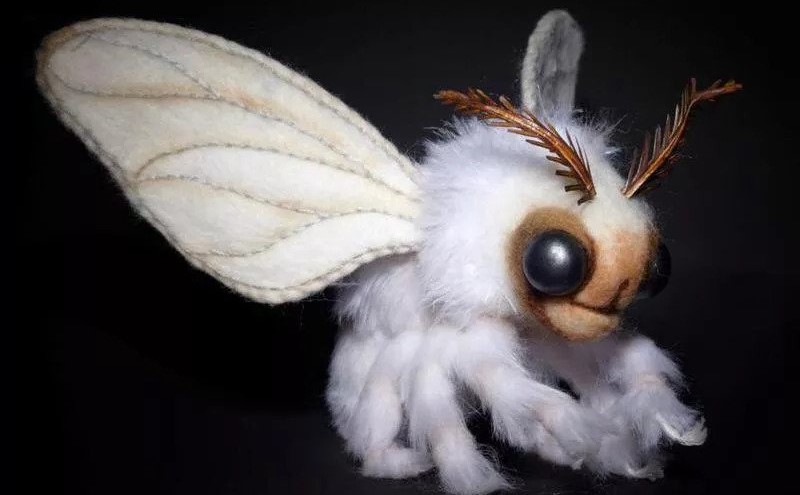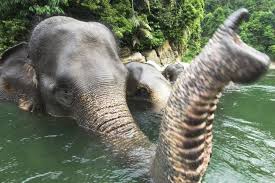Australian koala (Phascolarctos cinereus) – a species of mammal from the koala family (Phascolarctidae), an arboreal herbivorous animal, residing in eastern Australia. Koala comes to the ground only to move to another tree. It lives alone or in small groups consisting of a male and several females.
It is easily recognizable by its heavy, tailless body and large head with round, fluffy ears, and large, spoon-shaped nose. The koala has a body length of 60–85 cm (24–33 in) and weighs 4–15 kg (9–33 lb.). Fur color ranges from silver grey to chocolate brown. Koalas from the northern populations are typically smaller and lighter in color than their counterparts further south. These populations possibly are separate subspecies, but this is disputed.
They are asocial animals, and bonding exists only between mothers and dependent offspring. Adult males communicate with loud bellows that intimidate rivals and attract mates. Males mark their presence with discharges from scent glands located on their chests. Being pouched mammal, koalas give birth to underdeveloped young that crawl into their mothers’ pouches, where they stay for the first six to seven months of their lives. These young koalas, known as “Joeys”, are fully weaned around a year old. Koalas have few natural predators and parasites, but are threatened by various pathogens, such as Chlamydiaceae bacteria and the koala retrovirus.

*Fun Facts about Koala Bear*
- They are quite slow animals and are excellent climbers. They reach the upper parts of trees by firmly wrapping their legs around the tree trunk.
- They come down to earth only to change the tree.
- Koala is sometimes mistakenly associated with a bear. It is a marsupial in the koala family.
- They lead a lonely lifestyle. Smaller groups consisting of a male and a few females are less common.
- During the day they sleep on the branches. They belong to sleepers. Their sleep lasts from 16 to 18 hours a day. They activate at night to get food.
- Koalas can make long jumps to move from one tree to another.
- In their cheeks they have special bags that are used to store food.

- Although you may have heard people call them koala ‘bears’, these awesome animals aren’t bears at all – they are in fact marsupials. A group of mammals, most marsupials have pouches where their newborns develop.
- These magnificent mammals get their name form an Aboriginal* term meaning, ‘no drink’. It is believed this is because koalas get almost all their moisture from the leaves they eat, and rarely drink water.
- When an infant koala – called a joey – is born, it immediately climbs up to its mother’s pouch. Blind and earless, a joey uses its strong sense of touch and smell, as well as instinct, to find its way.
- The greatest threats to these animals are fires and diseases of eucalyptus, which is their main food.

- Koalas do not have much energy and, when not feasting on leaves, they spend their time dozing in the branches. Believe it or not, they can sleep for up to 18 hours a day!
- Although they live mainly in trees, they can also swim well.
- An interesting fact is that their main food is eucalyptus leaves. They only reach for water when there is drought in their area of occurrence.
- During the mating season, males make loud roars. They help the female choose her mate. The animals mate mainly between December and March. Gestation lasts between 25 and 35 days. During one pregnancy, the female gives birth to one young. After birth, the young are blind and have no fur. They do not even weigh 1g. For nearly half a year, they grow up in their mother’s bag. They are fed with milk for the first five months. They stay with their mother until the next mating season.
- The species of these animals is in danger of extinction. They were placed under complete protection in 1927. It is estimated that their population has decreased by 28% over the past 25 years.
- Australia is inhabited by 10 times more camels than koalas.
- Before the British reached Australia, more than 10 million individuals of these animals lived there. Currently, there are about 43,000 of them in the wild.
- Like humans, koalas have fingerprints.
- They live from 13 to 18 years in the wild.
- Lesbian behavior has been observed in captive females.

- An adult specimen is between 60 and 85 cm tall. Body weight ranges from 8 to 15 kg.
- An adult specimen is between 60 and 85 cm tall. Body weight ranges from 8 to 15 kg.
- Koalas survive on a diet of eucalyptus leaves and can eat up to a kilogram a day! Pretty impressive, considering eucalyptus is poisonous to most animals. Their special fibre digesting organ, called a caecum, helps to detoxify the chemicals in the leaves. However, they can be quite picky eaters, eating less than 50 of over 700 eucalypt species. Even then, they will often choose leaves at the top of the tallest trees that contain more liquid and nutrients.








